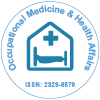Preventive Health Services: A Proactive Approach to Better Living
Received: 01-Mar-2025 / Manuscript No. omha-25-170278 / Editor assigned: 03-Mar-2025 / PreQC No. omha-25-170278 / Reviewed: 17-Mar-2025 / QC No. omha-25-170278 / Revised: 22-Mar-2025 / Manuscript No. omha-25-170278 / Published Date: 29-Mar-2025 DOI: 10.4172/2329-6879.1000569
Introduction
Preventive health services are essential components of a well-functioning healthcare system. Rather than focusing solely on treating diseases after they occur, preventive care emphasizes early detection, risk reduction, and the promotion of healthy behaviors to avoid illness altogether. These services include screenings, immunizations, health counseling, and routine check-ups [1],[2]. As healthcare systems globally shift from reactive to proactive care models, preventive health services are gaining recognition for their role in enhancing quality of life, reducing healthcare costs, and increasing life expectancy [3],[4].
Discussion
Preventive health services operate at three levels: primary, secondary, and tertiary prevention.
- Primary prevention aims to stop diseases before they begin, through interventions such as vaccinations, promoting physical activity, balanced nutrition, and anti-smoking campaigns. For example, immunizations against diseases like measles, polio, and COVID-19 protect individuals and communities by reducing the spread of infections [5].
- Secondary prevention focuses on early detection and timely intervention. Regular screenings for conditions such as high blood pressure, diabetes, cancer (like mammograms and colonoscopies), and cholesterol levels help identify risks or diseases at an early stage, when treatment is more effective and less costly [6],[7].
- Tertiary prevention seeks to manage and reduce complications of existing chronic diseases through rehabilitation programs, regular monitoring, and lifestyle adjustments. This level helps improve quality of life for patients and prevents further deterioration [8],[9].
One of the most valuable aspects of preventive care is its cost-effectiveness. By addressing health issues early or preventing them altogether, healthcare systems can save significant resources that would otherwise be spent on expensive emergency care or long-term treatments. For instance, controlling hypertension through early intervention can prevent heart attacks or strokes, both of which require extensive and costly care [10].
Preventive health services also play a crucial role in addressing the global rise in non-communicable diseases (NCDs) like heart disease, diabetes, and cancer. These conditions are often linked to modifiable lifestyle factors such as poor diet, lack of exercise, and tobacco use. Through counseling, education, and regular assessments, healthcare providers can empower individuals to take responsibility for their health and make informed lifestyle choices.
However, despite their benefits, preventive health services are often underutilized, especially in low- and middle-income countries. Barriers include lack of awareness, limited access to care, cultural beliefs, and financial constraints. To improve uptake, governments and health organizations must invest in health education, community outreach programs, and affordable preventive care services. Additionally, integrating preventive care into primary health services and insurance coverage can encourage more people to participate in regular check-ups and screenings.
Conclusion
Preventive health services are vital for creating healthier populations and sustainable healthcare systems. By focusing on early detection, education, and risk reduction, preventive care can significantly reduce the burden of disease, improve quality of life, and lower healthcare costs. As the saying goes, “prevention is better than cure.” A stronger emphasis on preventive services—supported by policy, public awareness, and accessible healthcare—can lead to a healthier, more resilient society for generations to come.
Reference
- https://www.oecd.org/education/skills-beyond-school/AHELOFSReportVolume1.pdf
- Arndt S, Smith K, Urban M, Ellegard T, Swadener BB, et al. (2020) Reconceptualising and (re)forming early childhood professional identities: Ongoing transnational policy discussions. Policy Futures Educ 19:406-423.
- https://www.mineducacion.gov.co/portal/salaprensa/Noticias/396244:Acceso-a-version-movil-del-portal-educativo-Colombia-Aprende-sera-gratuito-para-los-usuarios-con-servicios-de-telefonia-movil-prepago-y-pospago-de-hasta-71-214.
- https://www.hrw.org/report/2021/05/17/years-dont-wait-them/increased-inequalities-childrens-right-education-due-covid
- Partlow KM, Gibbs WJ (2003) Indicators of constructivist principles in internet-based courses. J Comput High Educ14:68-97.
- https://repositorium.sdum.uminho.pt/bitstream/1822/52318/1/Flores.pdf
- https://msutoday.msu.edu/news/2020/poor-internet-connection-leaves-rural-students-behind
- Jones AL, Kessler MA (2020) Teachers' Emotion and Identity Work During a Pandemic.Front Educ 5:583775.
- Ball SJ (2003) The teacher's soul and the terrors of performativity. J Educ Policy18: 215-228.
- Clandinin DJ, Connelly FM (1998) Stories to live by: narrative understandings of school reform.CurrInq 28:149-164.
Citation: Margaret A (2025) Preventive Health Services: A Proactive Approach to Better Living. Occup Med Health 13: 569. DOI: 10.4172/2329-6879.1000569
Copyright: © 2025 Margaret A. This is an open-access article distributed under the terms of the Creative Commons Attribution License, which permits unrestricted use, distribution, and reproduction in any medium, provided the original author and source are credited.
Select your language of interest to view the total content in your interested language
Share This Article
Recommended Journals
Open Access Journals
Article Tools
Article Usage
- Total views: 240
- [From(publication date): 0-0 - Dec 10, 2025]
- Breakdown by view type
- HTML page views: 179
- PDF downloads: 61
